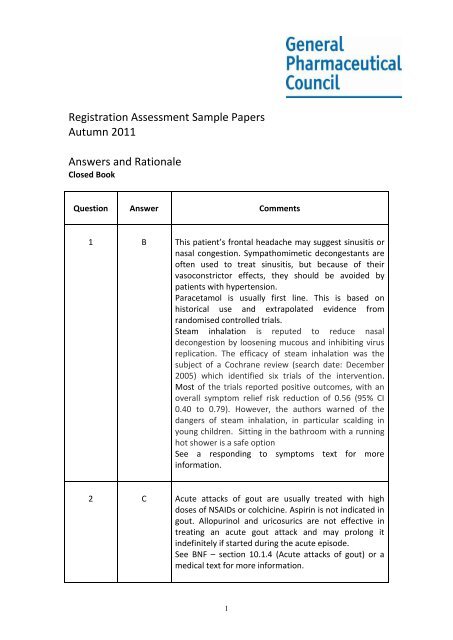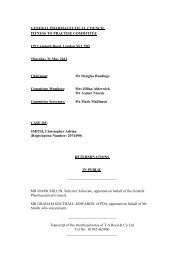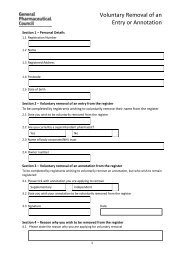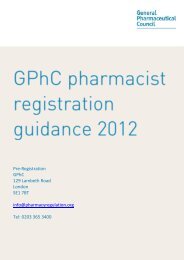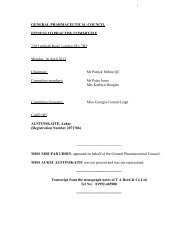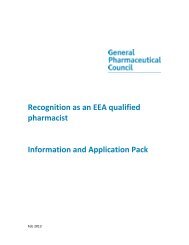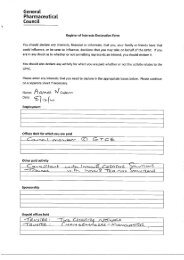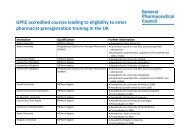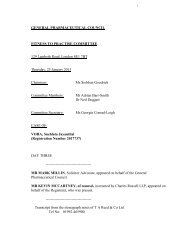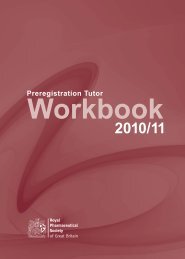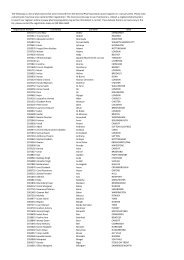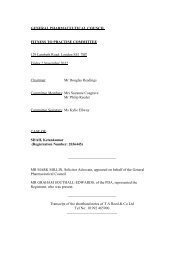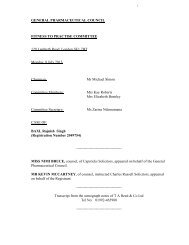Autumn 2011 sample papers
Autumn 2011 sample papers
Autumn 2011 sample papers
Create successful ePaper yourself
Turn your PDF publications into a flip-book with our unique Google optimized e-Paper software.
Registration Assessment Sample Papers<br />
<strong>Autumn</strong> <strong>2011</strong><br />
Answers and Rationale<br />
Closed Book<br />
Question Answer Comments<br />
1 B This patient’s frontal headache may suggest sinusitis or<br />
nasal congestion. Sympathomimetic decongestants are<br />
often used to treat sinusitis, but because of their<br />
vasoconstrictor effects, they should be avoided by<br />
patients with hypertension.<br />
Paracetamol is usually first line. This is based on<br />
historical use and extrapolated evidence from<br />
randomised controlled trials.<br />
Steam inhalation is reputed to reduce nasal<br />
decongestion by loosening mucous and inhibiting virus<br />
replication. The efficacy of steam inhalation was the<br />
subject of a Cochrane review (search date: December<br />
2005) which identified six trials of the intervention.<br />
Most of the trials reported positive outcomes, with an<br />
overall symptom relief risk reduction of 0.56 (95% CI<br />
0.40 to 0.79). However, the authors warned of the<br />
dangers of steam inhalation, in particular scalding in<br />
young children. Sitting in the bathroom with a running<br />
hot shower is a safe option<br />
See a responding to symptoms text for more<br />
information.<br />
2 C Acute attacks of gout are usually treated with high<br />
doses of NSAIDs or colchicine. Aspirin is not indicated in<br />
gout. Allopurinol and uricosurics are not effective in<br />
treating an acute gout attack and may prolong it<br />
indefinitely if started during the acute episode.<br />
See BNF – section 10.1.4 (Acute attacks of gout) or a<br />
medical text for more information.<br />
1
3 C Sildenafil (for erectile dysfunction) is only prescribable<br />
in certain circumstances under the NHS and the<br />
prescriber must endorse the prescription with the<br />
reference ‘SLS’.<br />
See BNF – section 7.4.5 – monograph for sildenafil or<br />
Drug Tariff for more information.<br />
4 A The pain of GORD is caused by the acid contents of the<br />
stomach leaking ‘backwards’ into the oesophagus. The<br />
symptoms arising are typically described as heartburn,<br />
which is pain arising in the upper abdomen passing<br />
upwards behind the breastbone.<br />
See a responding to symptoms or medical text for more<br />
information.<br />
5 E Alginate antacids can form a raft which floats on the<br />
surface of the stomach contents, thereby reducing<br />
symptoms of reflux.<br />
See a responding to symptoms or medical text for more<br />
information.<br />
6 A See CPD section at www.pharmacyregulation.org<br />
7 D Paracetamol, a para-aminophenol derivative, has<br />
analgesic and antipyretic properties and weak antiinflammatory<br />
activity.<br />
Paracetamol is given by mouth or as a rectal<br />
suppository for mild to moderate pain and for fever. It<br />
may also be given by intravenous infusion for the shortterm<br />
treatment of moderate pain, particularly after<br />
surgery.<br />
Paracetamol is metabolised mainly in the liver and<br />
excreted in the urine mainly as the glucuronide and<br />
sulphate conjugates. Less than 5% is excreted as<br />
unchanged paracetamol.<br />
Paracetamol is generally considered to be the analgesic<br />
of choice in pregnant patients.<br />
See Martindale – The Complete Drug Reference for<br />
more information.<br />
2
8 B The body's ability to process alcohol depends on various<br />
factors, e.g. age, weight and sex. Although there is<br />
variation, the body breaks down alcohol at an average<br />
rate of one unit per hour.<br />
See a health promotion text for more information.<br />
9 E Methadone is a Schedule 2 Controlled Drug and a<br />
pharmacist may only supply it to a patient on the<br />
authority of a prescription in the required form issued<br />
by an appropriate practitioner. In the case of instalment<br />
prescriptions, the first instalment must be dispensed<br />
within 28 days of the appropriate date, with the<br />
remainder of instalments dispensed in accordance with<br />
the instructions.<br />
Pharmacists should also be alert to the possibility of<br />
misuse of all Controlled Drugs.<br />
See MEP and BNF<br />
10 D Emergency supplies are not legally permitted for<br />
Controlled Drugs in Schedule 1, 2 or 3 (with the<br />
exception of phenobarbital).<br />
See BNF and MEP<br />
11 E BNF – section 6.1.2.2 – Biguanides.<br />
12 D The mineralocorticoid activity of hydrocortisone causes<br />
sodium and water retention which can result in<br />
hypertension.<br />
See BNF – section 6.3.2<br />
3
13 A Nurse advisors at NHS Direct / NHS 24 use decision<br />
support software to assist them in making an<br />
assessment and in giving advice. The software consists<br />
of clinical algorithms based on symptoms. Using these<br />
algorithms the advisor can assess, advise and refer<br />
callers to the NHS service that best suits their needs.<br />
The service was developed to provide quicker, easier<br />
and faster access to advice and information for<br />
members of the public about health, illness and the NHS<br />
so that they are better able to care for themselves and<br />
their families.<br />
All calls to NHS Direct / NHS 24 are confidential.<br />
Information is only shared with other health care<br />
professionals if the information is needed for an<br />
individual’s treatment and care, AND after the person<br />
has given their permission. Decision support for<br />
healthcare professionals is not provided.<br />
See www.nhsdirect.nhs.uk / www.nhs24.com /<br />
www.nhsdirect.wales.nhs.uk for more information.<br />
14 E Temazepam is a Schedule 3 Controlled Drug but is<br />
exempt from the prescription requirements for<br />
Controlled Drugs.<br />
See MEP and BNF<br />
15 A Buprenorphine is a Schedule 3 Controlled Drug.<br />
See MEP and BNF<br />
16 A An adequate intake of vitamin A is required during<br />
pregnancy but excessive intake is associated with an<br />
increased risk of birth defects. Foods which are<br />
particularly rich in vitamin A (e.g. liver) and vitamin A<br />
supplements should be avoided in women who are (or<br />
may become) pregnant.<br />
See ‘Dietary supplements’ by Pamela Mason or a health<br />
promotion text for more information.<br />
4
17 C Vitamin D compounds are fat-soluble sterols,<br />
sometimes considered to be hormones or hormone<br />
precursors, which are essential for the proper<br />
regulation of calcium and phosphate homeostasis and<br />
bone mineralisation.<br />
See ‘Dietary Supplements’ by Pamela Mason or a health<br />
promotion text for more information.<br />
18 E Vitamin K is an essential cofactor in the hepatic<br />
synthesis of prothrombin (factor II) and other blood<br />
clotting factors (factors VII, IX, and X, and proteins C and<br />
S).<br />
See ‘Dietary Supplements’ by Pamela Mason or a health<br />
promotion text for more information.<br />
19 C In humans the most significant supply of vitamin D<br />
comes from the action of ultra-violet light on sterols in<br />
the skin. Most people, including infants require little or<br />
no extra from food when regularly exposed to sunlight<br />
when the sun is high in the sky.<br />
See ‘Dietary Supplements’ by Pamela Mason or a health<br />
promotion text for more information.<br />
20 C This patient’s symptoms suggest that their dose of<br />
levothyroxine may be excessive.<br />
See BNF – section 6.2.1 – monograph for levothyroxine<br />
or a medical text for more information.<br />
21 E HRT causes an increased risk of thromboembolism and<br />
sudden breathlessness may indicate pulmonary<br />
embolism.<br />
See BNF – section 6.4.1.1 – Oestrogens and HRT for<br />
more information.<br />
22 E BNF – Appendix 3 – Cautionary and advisory labels for<br />
dispensed medicines.<br />
5
23 C BNF – Appendix 3 – Cautionary and advisory labels for<br />
dispensed medicines.<br />
24 D BNF – Appendix 3 – Cautionary and advisory labels for<br />
dispensed medicines.<br />
25 A See BNF – section 5.1.1 – Penicillins for more<br />
information.<br />
26 E Maintenance doses of warfarin depend on the<br />
prothrombin time, reported as the INR. See BNF –<br />
section 2.8.2 – Oral anticoagulants.<br />
Carbimazole is used to treat hyperthyroidism and<br />
dosage is based on thyroid function tests. See BNF –<br />
section 6.2.2 – Antithyroid drugs.<br />
Lithium has a narrow therapeutic / toxic ratio and<br />
should not be prescribed unless facilities for monitoring<br />
serum-lithium concentrations are available. See BNF –<br />
section 4.2.3 (Lithium).<br />
27 B Confidential information must only be disclosed without<br />
consent in exceptional circumstances or when<br />
permitted or required by law. For examples of the<br />
circumstances where information may be disclosed<br />
without consent.<br />
See 3.5 of the GPhC standards of conduct, ethics and<br />
performance.<br />
28 D Itchiness on the surface of the eyes may indicate allergic<br />
conjunctivitis which can be treated appropriately with<br />
non-prescription medicines. Visual disturbances or pain<br />
arising from within the eye indicate possible serious<br />
pathology and require urgent referral.<br />
See a responding to symptoms text for more<br />
information.<br />
29 D Rifampicin is a potent liver enzyme inducing agent<br />
which increases the metabolism and clearance of<br />
warfarin from the body, which would cause the INR to<br />
decrease.<br />
Cimetidine and fluconazole are enzyme inhibitors.<br />
6
See ‘Drug Interactions’ by Stockley and BNF for more<br />
information.<br />
30 E Levobunolol is a beta-adrenoceptor blocking drug which<br />
is used topically to treat glaucoma. Systemic absorption<br />
may follow topical application to the eyes, therefore<br />
eye drops containing a beta-blocker can cause systemic<br />
side-effects e.g. bradycardia.<br />
See BNF – section 11.6 – Treatment of glaucoma.<br />
31 A See BNF Emergency supplies of medicines.<br />
32 A Misoprostol can cause diarrhoea which may<br />
occasionally be severe and require withdrawal. See BNF<br />
– section 1.3.4 – monograph for misoprostol.<br />
Ferrous sulphate can cause gastro-intestinal irritation<br />
including both diarrhoea and constipation. See BNF –<br />
section 9.1.1.1 – Oral iron.<br />
Erythromycin can cause diarrhoea in some patients.<br />
See BNF – section 5.1.5 - Macrolides<br />
33 E Ramipril is an angiotensin-converting enzyme inhibitor<br />
which inhibits the conversion of angiotensin I to<br />
angiotensin II. Angiotensin II stimulates the synthesis<br />
and secretion of aldosterone (stimulating salt and water<br />
retention and potassium loss) and raises blood pressure<br />
via a potent direct vasoconstrictor effect. ACE inhibitors<br />
induce vasodilatation and enhance the renal excretion<br />
of salt and water while causing potassium to be<br />
retained. See BNF – section 2.5.5.1 – Angiotensinconverting<br />
enzyme inhibitors.<br />
Spironolactone is an aldosterone antagonist, therefore<br />
is potassium-sparing and can cause hyperkalaemia. See<br />
BNF – section 2.2.3 – Aldosterone antagonists.<br />
Furosemide is a loop diuretic which inhibits the<br />
reabsorption of electrolytes primarily in the thick<br />
ascending limb of the loop of Henle and also in the<br />
distal renal tubules. It may also have a direct effect in<br />
the proximal tubules. Excretion of sodium, potassium,<br />
calcium, and chloride ions is increased and water<br />
excretion enhanced. See BNF – section 2.2.2 – Loop<br />
diuretics.<br />
7
34 C Ethics has been described as the systematic study of<br />
moral choices. Ethical decision making is the process<br />
whereby one recognises that a problem needs to be<br />
overcome or a difficult choice made, identifies the<br />
possible courses of actions, chooses one, takes it & then<br />
accepts responsibility. Pharmacists will face ethical<br />
dilemmas in the course of their professional practice<br />
and are expected to use their professional judgement in<br />
deciding on the most appropriate course of action.<br />
35 B GTN is a vasodilator and unwanted effects include<br />
flushing, headache and postural hypotension which may<br />
limit therapy.<br />
See BNF – section 2.6.1 – Nitrates for more information.<br />
36 B Lithium and gentamicin are excreted mainly unchanged<br />
in the urine therefore a dosage reduction is necessary in<br />
patients with renal impairment.<br />
BNF – section 5.1.4 – Aminoglycosides - Gentamicin<br />
BNF – section 4.2.3 – Antimanic drugs - Lithium<br />
BNF – section 1.3.5 - Proton pump inhibitors -<br />
Omeprazole<br />
37 B The first and second statements are not linked because<br />
the reason that the patient or their carer should be told<br />
at the outset is to give the opportunity to take the<br />
prescription to another pharmacy.<br />
38 E The use of cyclizine is not restricted in young adults.<br />
Metoclopramide is restricted in patients under 20 years<br />
due to an increased risk of dystonic reactions.<br />
See BNF – section 4.6 – Drugs used in nausea and<br />
vertigo.<br />
8
39 D Excess ingredients should not be returned to their stock<br />
bottles as this could contaminate the stock.<br />
Disposal of waste must comply with the provisions of<br />
environmental protection legislation. Every producer<br />
of waste is under a duty to ensure safe handling and<br />
disposal of the waste.<br />
See MEP – Waste Disposal Arrangements.<br />
40 B The use of loop diuretics can increase the risk of digoxin<br />
toxicity due to the potential for them to cause<br />
hypokalaemia, which predisposes the patient to<br />
toxicity.<br />
The first and second statements are not linked because<br />
although loop diuretics can cause hyponatraemia, this<br />
does not predispose to digoxin toxicity.<br />
See BNF – section 2.1.1 – Cardiac glycosides for more<br />
information.<br />
41 D As you are required to prepare 300 mL of Gentian<br />
Mixture, Alkaline, BP a total of 150 mL of Double-<br />
Strength Chloroform Water BP is required.<br />
Concentrated Chloroform Water BP needs to be diluted<br />
1 in 20 to prepare Double-Strength Chloroform Water<br />
BP, therefore the volume of Concentrated Chloroform<br />
Water BP that is required is 7.5 mL.<br />
42 C Vaginal candidiasis occurs commonly in pregnancy. Any<br />
pregnant woman with vaginal candidiasis should be<br />
referred to their GP to confirm the diagnosis and<br />
exclude other potential causes.<br />
See a responding to symptoms text for more<br />
information.<br />
9
43 C The reason that it would be illegal to provide the<br />
emergency supply is that the pharmacist has not<br />
interviewed the person requesting the medicine. There<br />
is no legal age limit for emergency supplies.<br />
See BNF Emergency supplies of medicines.<br />
44 C The patient should be advised to see his GP as the<br />
yellow/green sputum may indicate that he has a chest<br />
infection such as bronchitis or pneumonia. Patients<br />
should be advised to see their GP if their cough has<br />
lasted 2 weeks or more and is not improving.<br />
See a responding to symptoms text for more<br />
information.<br />
45 A See 1.1 of the standards of conduct, ethics and<br />
performance. In addition it is the responsibility of<br />
pharmacists in positions of authority to ensure that<br />
systems are in place to ensure that the supplier and the<br />
quality of medicines obtained are reputable.<br />
The first and second statements are linked because the<br />
reason that the superintendent pharmacist must check<br />
the credentials of the wholesaler is primarily to ensure<br />
that the supplier and goods are reputable.<br />
10
Open Book<br />
Question Answer Comments<br />
1 D BNF – section 5.1 Table 1 – Summary of antibacterial<br />
therapy<br />
2 A BNF – section 3.6 Oxygen<br />
3 C BNF – section 2.1.1<br />
4 B BNF – section 2.3.1 Management of arrhythmias (Atrial<br />
fibrillation)<br />
5 D BNF – section 4.3.3 Selective serotonin re-uptake<br />
inhibitors (Interactions)<br />
6 E BNF – section 5.1.1.2 – monograph for flucloxacillin<br />
7 B BNF – section 13.4 – monograph for hydrocortisone<br />
Non-prescription hydrocortisone cream is indicated for<br />
the treatment of allergic contact dermatitis.<br />
Promethazine and chlorphenamine both contain a<br />
sedating antihistamine (BNF – section 3.4.1) and are<br />
more appropriate if systemic treatment is needed and<br />
sedation is acceptable.<br />
8 B BNF – Prescribing in palliative care (Nausea and<br />
vomiting)<br />
9 D BNF – section 9.1.2 – monograph for folic acid<br />
10 E BNF – section 4.7.4.3 Cluster headache<br />
11 B<br />
BNF - Adverse reactions to drugs and Tarka®<br />
monograph<br />
11
12 D BNF - Adverse reactions to drugs and pioglitazone<br />
monograph<br />
13 E BNF - Adverse reactions to drugs and atorvastatin<br />
monograph<br />
14 A BNF - Adverse reactions to drugs and amlodipine<br />
monograph<br />
15 B BNF - Dental Practitioner’s Formulary<br />
16 C BNF - Nurse Prescribers Formulary<br />
17 C BNF – section 4.8.1 Control of epilepsy<br />
18 D BNF – see individual monographs (1.6.2 Stimulant<br />
laxatives and 1.6.1 Bulk-forming laxatives)<br />
19 A Standards of conduct, ethics and performance<br />
20 E BNF - Controlled Drugs and drug dependence<br />
21 C BNF – section 12.3.5 Treatment of dry mouth<br />
12
22 A Insomnia associated with Singulair® (BNF – section 3.3.2<br />
– monograph for montelukast) should be reported to<br />
the MHRA because the patient is a child (all suspected<br />
reactions should be reported in children – see BNF –<br />
Adverse reactions to drugs).<br />
Cleft palate possibly caused by prednisolone should be<br />
reported as it is a congenital abnormality (see BNF –<br />
Adverse reactions to drugs).<br />
All suspected adverse reactions caused by Competact®<br />
should be reported as Competact® is still being<br />
intensively monitored by the MHRA (BNF – section<br />
6.1.2.3 – monograph for pioglitazone).<br />
23 E See the GPhC standards of conduct, ethics and<br />
performance, number 3.5.<br />
24 E See individual monographs in BNF:<br />
vindesine – section 8.1.4<br />
amsacrine – section 8.1.5<br />
methotrexate – section 8.1.3<br />
25 A BNF – Appendix 4 – Intravenous additives<br />
The table states that bumetanide is compatible with<br />
glucose 5% and sodium chloride 0.9%.<br />
26 B BNF – section 4.3.4 – monograph for flupentixol<br />
The first and second statements are not linked because<br />
the reason that flupentixol should not be taken in the<br />
evening is because it can have an alerting effect.<br />
27 C BNF – Appendix 1 – Interactions<br />
13
28 D BNF – section 12.2.1 – monograph for beclometasone<br />
nasal spray<br />
29 D BNF – section 4.3.3<br />
30 A BNF – section 5.4.1 Antimalarials (Asplenia)<br />
The spleen is involved in producing protective humoral<br />
antibodies, the production and maturation of B and T<br />
cells and plasma cells, removal of unwanted particulate<br />
matter (e.g. bacteria) and it also acts as a reservoir for<br />
blood cells, especially white cells and platelets,<br />
therefore fulminant, potentially life-threatening<br />
infection is a major long-term risk of hyposplenism.<br />
The first and second statements are linked because it is<br />
due to the increased risk of severe falciparum malaria<br />
that patients with severe splenic dysfunction should be<br />
strongly advised to take all anti-malarial<br />
precautions/prophylaxis and ideally avoid holidays in<br />
malaria endemic areas.<br />
14
Calculations<br />
Question Answer Comments<br />
31(Calc) C Benylin Dry Coughs® (Original) contains 14 mg of<br />
diphenhydramine hydrochloride in 5 mL<br />
280 mg in 100 mL<br />
2.8 g in 1 L<br />
2.8 g x 150 L = 420 g<br />
32(Calc) D 1 mole of potassium chloride weighs 74.5 g<br />
1 mmol = 74.5 mg<br />
The solution to be prepared contains 6 mmol potassium<br />
ions in 5 mL<br />
120 mmol in 100 mL<br />
600 mmol in 500 mL<br />
600 x 74.5 mg = 44.7 g<br />
33(Calc) C Dobutamine dose = 4.5 mcg/kg/minute & patient<br />
weighs 55 kg<br />
dose = 4.5 x 55 = 247.5 mcg/minute<br />
After 1 hour the patient will have received 60 x<br />
247.5mcg = 14.85 mg<br />
34(Calc) C Digoxin tablets have a bioavailability of 0.7 70% of<br />
the administered dose is available.<br />
Digoxin elixir has a bioavailability of 0.8 80% of the<br />
administered dose is available.<br />
The dose of digoxin elixir (y) that must be given to<br />
provide an equivalent dose to the tablets can be<br />
calculated as follows:<br />
80% of y = 70% of 125 mcg<br />
80% = 0.8<br />
0.8 x y = 0.7 x 125<br />
y = (0.7/0.8) x 125 = approximately 110 mcg<br />
35(Calc) E A 1 in 8000 solution contains 1 g in 8000 mL<br />
125 mg in 1000 mL<br />
12.5 mg in 100 mL<br />
50 mg in 400 mL<br />
15
36(Calc) B BNF – section 2.3.2 – monograph for amiodarone<br />
Dose = 200 mg 3 times daily for 1 week reducing to 200<br />
mg twice daily for a further week; maintenance dose,<br />
usually 200 mg daily.<br />
1 tablet tds for 7 days = 21 tablets<br />
1 tablet bd for 7 days = 14 tablets<br />
1 tablet od for 14 days = 14 tablets<br />
Total = 49 tablets<br />
37(Calc) C BMI = weight (kg) height (m) 2<br />
weight = BMI x height (m) 2<br />
To calculate the weight that will give Mrs S a BMI of 20:<br />
= 20 x 1.65 2 = approximately 55 kg<br />
To calculate the weight that will give Mrs S a BMI of 25:<br />
= 25 x 1.65 2 = approximately 68 kg<br />
38(Calc) A BNF – section 9.6.4 – monograph for alfacalcidol<br />
Dose = 50 ng/kg daily<br />
50 ng x 4 kg = 200 ng daily = 0.2 mcg<br />
39(Calc) B Remifentanil dose = 0.05 mcg/kg/minute & child weighs<br />
16 kg<br />
dose = 0.05 x 16 = 0.8 mcg/minute<br />
After 25 minutes the child will have received 25 x 0.8 =<br />
20 mcg = 0.02 mg<br />
40(Calc) E BNF – section 9.1.1.1 Oral iron<br />
200 mg dried ferrous sulphate contains 65 mg of ferrous<br />
iron<br />
Fersamal® syrup contains 45 mg of iron / 5 mL<br />
85.5 mg iron in 9.5 mL<br />
Sytron® elixir contains 27.5 mg of iron / 5 mL<br />
41.25 mg iron in 7.5mL<br />
Niferex ®elixir contains 100 mg of iron / 5 mL<br />
65 mg iron in 3.25 mL<br />
16


